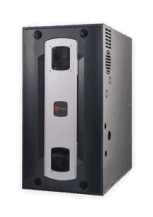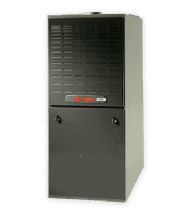HVAC Troubleshooting
Follow our interactive troubleshooting guide to find answers to your system’s problems.
Choose from a selection of common HVAC issues or pick your product for help with fixes you can try yourself.
Furnace Troubleshooting: 7 Gas Furnace Solutions
There’s nothing worse than waking up on a winter day to a home that feels as cold inside as the temperature outside! If this is a situation you’ve found yourself in, a furnace not working could be what’s causing your chilly mornings.
While you need to call an HVAC professional right away if you smell gas or hear strange noises coming from your furnace, in some cases the problem can be minor and you might be able to do some furnace troubleshooting on your own. Here’s our list of seven gas furnace troubleshooting solutions that are safe for you to try.
WARNING: Attempting to repair your furnace yourself can have major safety and health consequences. If your furnace is powered by natural gas, improper repair can result in dangerous leaks that can expose your family to toxic fumes and the risk of explosions. Electric furnaces can shock you during wiring work. Always consult a licensed HVAC professional if you are experiencing mechanical issues with your furnace.
Gas furnace troubleshooting checklist
Check these seven furnace troubleshooting tips before you call in the pros.
 Make sure your thermostat is on and set to ‘heat’
Make sure your thermostat is on and set to ‘heat’
The problem might not even be your furnace at all — it may be your thermostat! Before you call a professional, check your thermostat and make sure it’s on. It’s possible your thermostat may need new batteries or was just switched off by mistake. Once you ensure your thermostat is on, make sure it’s set to ‘heat’ at a temperature at least five degrees above room temperature.
 Open the vents throughout your home
Open the vents throughout your home
Your furnace functions by making heat, then pumping that hot air through all your vents to, ultimately, raise the temperature. If your home isn’t feeling warm, but your furnace is on, make sure all your vents are completely open. Vents can be found on the floor, ceiling, or walls in each room of your home. If they’re blocked or closed, heat will not be able to flow.
 Clean or have your furnace filter replaced
Clean or have your furnace filter replaced
If you feel like your furnace is still producing some heat, but not enough, the culprit could be a clogged or dirty furnace filter. All HVAC systems, including furnaces, heat pumps, cooling devices and more, have filters that homeowners should change regularly.
The first step in checking your furnace filter is locating it, but before you do that ensure your furnace is completely turned off. The filter is always situated near the blower, which is the part of your furnace where hot air exits so it’s blown throughout your home. Exactly where your blower is located depends on how your furnace was installed:

If you have a horizontal-facing furnace, the blower will be on the side and the filter will be slid into a rack.

If you have a vertical-facing furnace, the filter will be in either the top or bottom doors, depending on whether air is flowing upward or downward through the blower.
After locating your filter, inspect it for any dust or debris.
Note: NEVER operate your furnace WITHOUT a filter as this can lead to severe and expensive problems.
If you have one-time use filters in your furnace and yours looks particularly dirty, swap the filter out for an entirely new one. If your furnace filter is permanent, rinse the dirty filter with water and allow it to air-dry completely before putting it back into your furnace.
 Check the furnace switch and your home’s breaker panel
Check the furnace switch and your home’s breaker panel
If your furnace is not heating, it might not be getting any power to produce any heat. First, check the general power switch on your furnace. Make sure no one in your home hit it and flipped it off by accident. If that switch is still on, find your home’s main electrical panel and look for the switch labeled ‘heat’ or ‘furnace.’ Make sure that’s also on, and toggle it back and forth between on and off one time. If this results in a fuse blowing, contact an HVAC professional because there may be a bigger furnace problem at hand.
 Look for a blue furnace flame
Look for a blue furnace flame
In older furnace models, a blue, even flame should be visible through the opening in your furnace at all times. Newer models use an electric ignition system that only lights when necessary, so they don’t have these flames. If your furnace does have a flame, and you see yellow or uneven flames instead of blue ones, you may have dirty burners or burners blocked with debris. If you notice this furnace problem, call an HVAC professional and schedule furnace and burners maintenance.
 Relight the pilot light or check electric igniter
Relight the pilot light or check electric igniter
As we mentioned earlier, older model furnaces burn visible blue flames. If your furnace has a blue flame, it’s lit by the pilot light. On the other hand, newer model furnaces function with an electric ignition that eliminates the need for a constant flame.
If your furnace has a pilot light, it will be controlled by a knob on the bottom of your unit. You can easily relight the pilot light by turning the knob to ‘off,’ waiting a minute, then setting it back to ‘on.’ This will stop and restart the gas flow of your furnace.
If you have a newer furnace with an electric igniter contact an HVAC professional for advice on next steps.
 Check the gas valve
Check the gas valve
Your furnace’s gas valve is made up of two valves: the safety valve, which supplies gas to the pilot light, and the main valve, which supplies gas to the burner trays. If your pilot light isn’t on, make sure the gas valve, located in the service panel on the side of the furnace, is on and supplying gas to the pilot light. If you suspect you have a gas leak, LEAVE YOUR HOME IMMEDIATELY and call 9-1-1, then contact an HVAC professional immediately from a safe location.
When to call a professional
If you spot these furnace issues, call in an HVAC professional as soon as possible.
 If you smell gas in the house
If you smell gas in the house
Small, fleeting scents of gas coming from a furnace can be normal, especially if you’ve just turned it on for the heating season. A strong, lingering gas scent coming from your furnace could indicate your furnace has a dangerous leak and you need to LEAVE YOUR HOME IMMEDIATELY and call 9-1-1. Contact an HVAC professional from a safe location.
It’s also important to install carbon monoxide detectors throughout your home. Your furnace burns fuel, which makes carbon monoxide. A properly functioning furnace will be able to deposit this dangerous gas in a safe manner, but if your furnace isn’t maintained correctly, this gas could build up to lethal levels in your home. Carbon monoxide is a deadly odorless and colorless gas, so it’s essential all homeowners install detectors. If your carbon monoxide detector is going off, LEAVE YOUR HOME IMMEDIATELY and call 9-1-1.
 If your furnace is making unusual noises
If your furnace is making unusual noises
Any loud hissing or banging noises could indicate a larger problem at hand. If you hear strange noises coming from your furnace, there may be an electrical issue within your unit. Call an HVAC professional to troubleshoot your furnace in this case.
 If troubleshooting does not fix the problem
If troubleshooting does not fix the problem
If you’ve tried everything on this list, or are uncomfortable trying yourself, and your home is still feeling cold, it’s time to call in an HVAC professional. Beyond these steps, your furnace likely requires maintenance or replacement that only someone with professional knowledge of HVAC devices can perform.
Is your HVAC system still experiencing issues?
Your local Trane dealer can help.Maintenance Tips
A healthy HVAC system can last longer and save money. Maintain your system with these tips.
Owner’s Manual
Learn more about your product, like its technical specs and innovative technology.
Warranty & Registration
After getting a new system, be sure to protect it with a warranty.
Contact a local dealer
Dealers can answer questions, help you find the right products for your home, and repair your system.
We’re here to help
Connect with our Customer Care team about your products, warranties, and dealer concerns.
Available Monday – Friday from 7am to 5pm CST
A phone